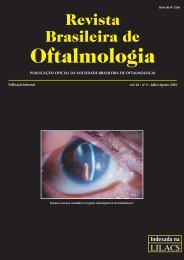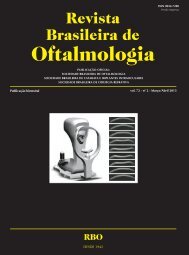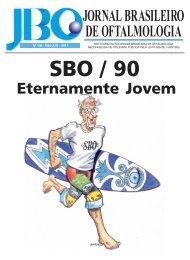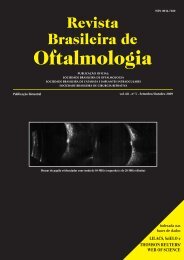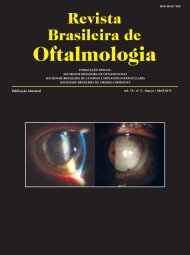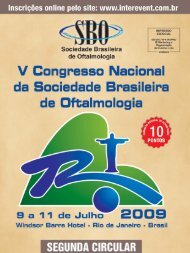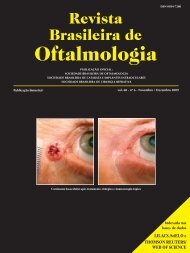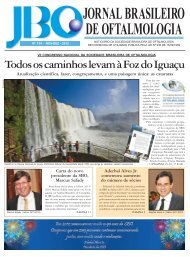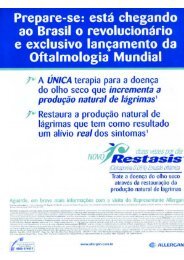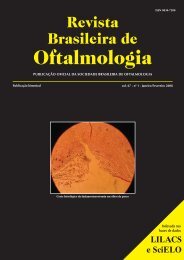Jan-Fev - Sociedade Brasileira de Oftalmologia
Jan-Fev - Sociedade Brasileira de Oftalmologia
Jan-Fev - Sociedade Brasileira de Oftalmologia
- No tags were found...
You also want an ePaper? Increase the reach of your titles
YUMPU automatically turns print PDFs into web optimized ePapers that Google loves.
Comparison of central corneal e<strong>de</strong>ma and visual recovery between liquefaction and conventional...<br />
11<br />
RESUMO<br />
Objetivo: Avaliar o e<strong>de</strong>ma corneano central e a recuperação<br />
visual após cirurgia <strong>de</strong> catarata realizada através <strong>de</strong><br />
duas tecnologias: ultrassônica convencional e liquefação<br />
(Aqualase ® ). Métodos: Estudo retrospectivo com análise<br />
contralateral, on<strong>de</strong> 20 pacientes se submeteram à<br />
facectomia sob condições pré-operatórias comparáveis.<br />
A avaliação pré-operatória envolveu exame<br />
oftalmológico completo com graduação da catarata <strong>de</strong><br />
acordo com o Lens Opacity Classification System II, e<br />
foram incluídos no estudo pacientes com catarata nuclear<br />
bilateral até grau II. A mesma técnica cirúrgica foi<br />
realizada em todos os casos pelo mesmo cirurgião, utilizando<br />
as duas tecnologias: liquefação e facoemulsificação<br />
convencional. As medidas do e<strong>de</strong>ma corneano pós-operatório<br />
foram realizadas com paquímetro óptico corneano<br />
(Orbscan II ® ) nos dias 1, 3, 7 e 10 <strong>de</strong> pós-operatório. Resultados:<br />
Nenhum dos pacientes inicialmente inscritos no<br />
estudo foi excluído ou perdido durante o seguimento. No<br />
primeiro dia pós-operatório a acuida<strong>de</strong> visual média foi<br />
<strong>de</strong> 0.031 logMAR no grupo <strong>de</strong> Aqualase e 0.043 logMAR<br />
no grupo convencional. Nenhuma diferença estatisticamente<br />
significativa foi <strong>de</strong>tectada na análise <strong>de</strong> acuida<strong>de</strong><br />
visual durante o período pós-operatório. A paquimetria<br />
corneana central variou <strong>de</strong> 543.93 + 34.69 no pré-operatório<br />
para 545.08 ± 25.67 no último dia <strong>de</strong> acompanhamento<br />
no grupo <strong>de</strong> Aqualase e <strong>de</strong> 543.13 + 30.62 para<br />
536.08 + 34.89 no grupo convencional, sem diferença estatisticamente<br />
significativa. Conclusão: O estudo sugere<br />
que as duas técnicas são igualmente eficaz para as cirurgias<br />
nucleares graus I e II, além <strong>de</strong> apresentarem resultados<br />
similares em relação ao e<strong>de</strong>ma corneano central e à<br />
recuperação visual.<br />
Descritores: Facoemulsificação/methods; Extração<br />
<strong>de</strong> catarata/métodos Técnicas, medidas e equipamentos<br />
<strong>de</strong> medição; Técnicas <strong>de</strong> diagnóstico oftalmológico;<br />
Biometria/instrumentação<br />
REFERENCES<br />
1. Thompson AM, Sach<strong>de</strong>v N, Wong T, Riley AF, Grupcheva CN,<br />
McGhee CN. The Auckland Cataract Study: 2 year<br />
postoperative assessment of aspects of clinical, visual, corneal<br />
topographic and satisfaction outcomes. Br J Ophthalmol.<br />
2004;88(8):1042-8.<br />
2. Hirst LW, Snip RC, Stark WJ, Maumenee AE. Quantitative<br />
corneal endothelial evaluation in intraocular lens<br />
implantation and cataract surgery. Am J Ophthalmol.<br />
1977;84(6):775-80.<br />
3. Irvine AR, Kratz RP, O’Donnell JJ. Endothelial damage with<br />
phacoemulsification and intraocular lens implantation. Arch<br />
Ophthalmol. 1978;96(6):1023-6.<br />
4. Duroviæ BM. [Endothelial trauma in the surgery of cataract].<br />
Vojnosanit Pregl. 2004;61(5):491-7. Serbian.<br />
5. Hoffman RS, Fine IH, Packer M. New phacoemulsification<br />
technology. Curr Opin Ophthalmol. 2005;16(1):38-43.<br />
6. Kara-José Júnior N. Cirurgia <strong>de</strong> catarata: aspectos clínicos e<br />
socio-econômicos [tese]. São Paulo: Faculda<strong>de</strong> <strong>de</strong> Medicina<br />
da Universa<strong>de</strong> <strong>de</strong> São Paulo; 2002.<br />
7. Grupcheva CN, Riley AF, Craig JP, Malik TY, McGhee CN.<br />
Analyzing small-incision cataract surgery by Orbscan II fourthdimensional<br />
pachymetry mapping. J Cataract Refract Surg.<br />
2002;28(12):2153-8.<br />
8. Alió J, Rodríguez-Prats JL, Galal A, Ramzy M. Outcomes of<br />
microincision cataract surgery versus coaxial<br />
phacoemulsification. Ophthalmology. 2005;112(11):1997-<br />
2003. Comment in: Ophthalmology. 2006;113(9):1687; author<br />
reply 1687.<br />
9. Alió JL, Schimchak P, Montés-Micó R, Galal A. Retinal image<br />
quality after microincision intraocular lens implantation. J<br />
Cataract Refract Surg. 2005;31(8):1557-60.<br />
10. Sippel KC, Pineda R Jr. Phacoemulsification and thermal<br />
wound injury. Semin Ophthalmol. 2002;17(3-4):102-9.<br />
Review.<br />
11. Lundberg B, Jonsson M, Behndig A. Postoperative corneal<br />
swelling correlates strongly to corneal endothelial cell loss<br />
after phacoemulsification cataract surgery. Am J Ophthalmol.<br />
2005;139(6):1035-41.<br />
12. Jurowski P, Goœ R, Kuœmierczyk J, Owczarek G, Gralewicz<br />
G. Quantitative thermographic analysis of viscoelastic<br />
substances in an experimental study in rabbits. J Cataract<br />
Refract Surg. 2006;32(1):137-40.<br />
13. Eda M, Matsushima H, Terauchi W, Mukai K, Izumida S, Obara<br />
Y, et al. [Protective effect on the corneal endothelium and<br />
remaining effect at the anterior chamber for three different<br />
kinds of viscoelastic <strong>de</strong>vices]. Nippon Ganka Gakkai Zasshi.<br />
2006;110(1):31-6. Japanese.<br />
14. Jurowski P, Goœ R, Owczarek G, Gralewicz GZ. Corneal<br />
endothelial cells’ protection against thermal injury: influence<br />
of ophthalmic viscoelastic substances in experimental study<br />
on rabbits. Eur J Ophthalmol. 2005;15(6):674-9.<br />
15. Kiss B, Findl O, Menapace R, Petternel V, Wirtitsch M, Lorang<br />
T, et al. Corneal endothelial cell protection with a dispersive<br />
viscoelastic material and an irrigating solution during<br />
phacoemulsification: low-cost versus expensive combination.<br />
J Cataract Refract Surg. 2003;29(4):733-40.<br />
16. Mackool RJ, Brint SF. AquaLase: a new technology for cataract<br />
extraction. Curr Opin Ophthalmol. 2004;15(1):40-3.<br />
17. Hughes EH, Mellington FE, Whitefield LA. Aqualase for<br />
cataract extraction. Eye. 2007;21(2):194-4.<br />
18. Doughty MJ, Müller A, Zaman ML. Assessment of the<br />
reliability of human corneal endothelial cell-<strong>de</strong>nsity estimates<br />
using a noncontact specular microscope. Cornea.<br />
2000;19(2):148-58.<br />
19. Wirbelauer C, Wollensak G, Pham DT. Influence of cataract<br />
surgery on corneal endothelial cell <strong>de</strong>nsity estimation. Cornea.<br />
2005;24(2):135-40.<br />
20. Arshinoff SA. Dispersive-cohesive viscoelastic soft shell<br />
technique. J Cataract Refract Surg. 1999;25(2):167-73.<br />
21. Sanchis-Gimeno JA, Herrera M, Lleó-Pérez A, Alonso L,<br />
Rahhal MS, Martínez-Soriano F. Quantitative anatomical<br />
differences in central corneal thickness values <strong>de</strong>termined<br />
with scanning-slit corneal topography and noncontact specular<br />
microscopy. Cornea. 2006;25(2):203-5.<br />
Rev Bras Oftalmol. 2009; 68 (1): 7-12



